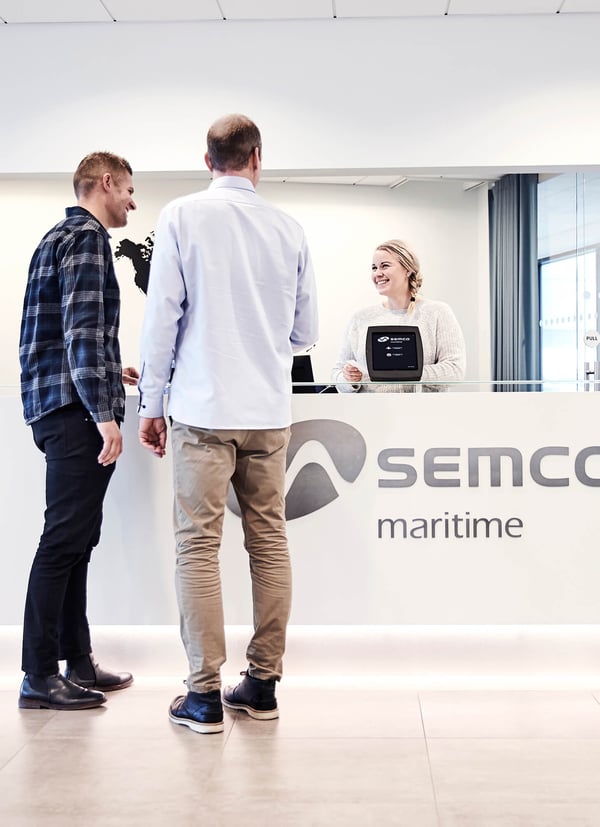Head office
Esbjerg, Denmark
Semco Maritime A/S
Esbjerg Brygge 30
6700 Esbjerg
Denmark
CVR no. DK 2549 0762
REX-no. DKREX170591191
EORI no. DK25490762








General enquiries
Tel. +45 7916 6666
semco@semcomaritime.com
Semco Maritime
Esbjerg Brygge 30
DK- 6700 Esbjerg

Our unique offshore and onshore experience combines the latest green technologies with 40 years of experience in Oil & Gas, conventional power plants and transmission systems; putting us in an enviable position to support the market needs.
Our data driven tools support your decision making in the due diligence process of the investment and thereafter in its execution and lifetime operation & maintenance. We help with diversifying and increasing your revenue streams, exploiting the full potential of your initiatives and installations.
The current grids for electricity and gas transmission are buckling, trying to keep up with the exponential development plans in the Green Transition. Potential investors are grappling with guarantees for demand and prices for the offtake. But the gains are huge and you risk missing out! Use our experience to help you make the right and informed decisions.
We solve the puzzle of solutions that can open doors to new business cases focused 100% on applying the latest innovations in Green and Blue Technologies.
Semco Maritime brings more than 40 years of experience in EPC & O&M scopes for the Oil & Gas, renewables and Power Transmission networks. Hybrid Greentech brings the latest/state of the art expertise in electrical energy storage, PtX and electricity markets.
Let our partnership inspire and support your initiatives from concept, through the project life cycle, operations and finally to repowering or recycling.

Several energy storage and Power to X product suppliers do not offer EPC deliveries. With the cooperation between Hybrid Greentech and Semco Maritime we can service renewable energy developers in all phases from greenfield to decommissioning for cost effective integration of large scale energy storage and Power to X solutions.
With governments and companies creating strategies to reach net-zero emission by 2050, and some much earlier, the decarbonization of the energy supply has become crucial. The performance and capacity of renewable energy sources increase - and energy sources wind and solar are being pushed & developed exponentially.

When these sources cannot keep up with the expected demand and when the capacity & production of the current renewable sources begin to experience difficulties in selling their offtake, i.e. insufficient immediate consumption, solutions need to be developed. Greenfield alternatives need to be developed and built to cover the capacity demand and to store or convert overproduction into another energy form.
Hydrogen & Ammonia and Battery Storage are now the hottest technologies being discussed and implemented as key aspects within governmental decarbonization strategies. Other technologies using various salts and chemicals are being investigated and tested for consumption suitability and economic viability.
Projects such as energy islands which were initially met with scepticism are now being actively bid for by large energy organisations. Initiatives are already in place with projects approved in Germany, Holland and Denmark. Many soon to follow.
Hydrogen can be produced in a number of ways. Grey hydrogen is produced from the steam in natural gas, blue hydrogen is produced through carbon capture and storage and the green hydrogen is primarily produced from renewable electricity, powering an electrolysis process of sea water.
Ammonia is produced by a synthesis, by catalytically reacting and thereby combining molecules of nitrogen(N2) and hydrogen(H2) to produce NH3. A process referred to as the Haber-Bosch process.
The advantages and disadvantages of using either hydrogen or ammonia as fuels in aviation, land & maritime vehicles(vessels) are heavily debated with reference to efficiency, usage of existing infrastructure, calorific values, storage & transport conditions, proximity between production and consumption sites. Many initiatives are in place to investigate how existing oil & gas infrastructure can be used to transport and distribute these new fuels. Studies show also potential in using existing oil & gas rigs to farm hydrogen, while others try to investigate how existing conventional power plants, ships and large land vehicles can be slightly modified to consume these new fuels.
Renewable energy sources in the grid are drastically reducing the CO2 emissions of our grid, but their fluctuation can lead to stability and availability challenges. battery Energy Storage systems are a versatile scalable and flexible and effective way of reducing the stress, the congestion and the voltage and frequency drops that our grids are facing nowadays.
Our expertise covers:
The most common and versatile battery energy system. The most efficient way to store electricity. Their fast response allows to use them both in energy application but most of all in power application, for example operating in the ancillary service markets. This allows to have several revenue stacks and a low payback time of the asset.
Applications:
Peak shaving, Frequency control, Voltage control, Load balancing, Ramp rate control
and Energy time shift.
The higher longevity and lower Levelized Cost of Storage (LCOS) and lower energy density makes them ideal for stationary application where the main aim is to reduce the CO2 emissions displacing high amount of energy over time.
Applications:
Peak shaving, Load balancing and Energy time shift.
Our feasibility studies will unfold a suite of technical options and concepts which would provide tangible input to the financial modelling of the business decision process to complete investment case justifications for energy grids, battery storage, power to X facilities.
Services consists of but not limited to:
Our robust, skilled and experienced toolbox puts us in a leading position to provide Complete Engineering Design, Procurement & Supply Chain Management; and Construction & Commissioning for the entire facility.
We can package all of this in a neat turnkey package, providing the customer with a low risk investment knowing that the project lies in good hands. We urge you to ask our customers in the Oil & Gas and Renewable sectors on what they think of our deliveries.
Once the facility is commissioned, the investment needs a robust asset management throughout its lifetime to ensure continued high returns on your investment. Our efficient planning and multi-skilled service technicians and asset management teams secure maximum uptime and lowest maintenance costs.
Our AI based software allows predictive maintenance and maximum utilization of your asset, creating new revenue streams with no additional effort from the customer.
Our state of the art operation & maintenance packages are modular and therefore can be configured to your specific needs.
When the time comes where the asset is required to be decommissioned, whether by law or economics, we will be there to support too.
We take into account the repowering, decommissioning and recycling from the start of the project so that once the systems are at the end of their lifetime, we can repurpose material which can be repurposed and ensure sustainable disposal of material which cannot be repurposed.
Semco Maritime A/S
Esbjerg Brygge 30
6700 Esbjerg
Denmark
CVR no. DK 2549 0762
REX-no. DKREX170591191
EORI no. DK25490762
